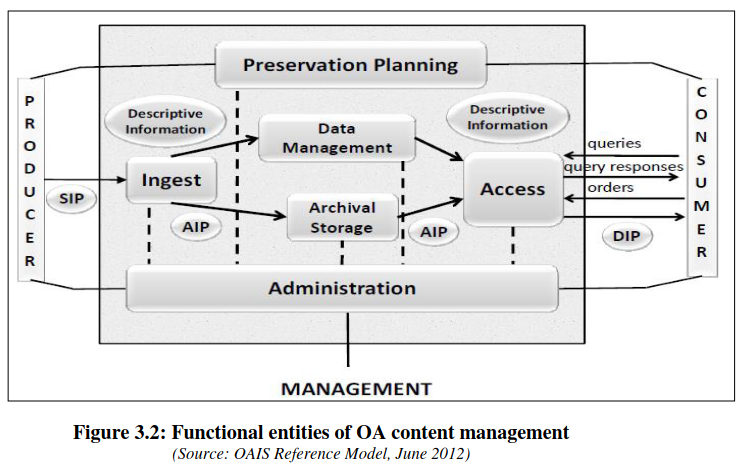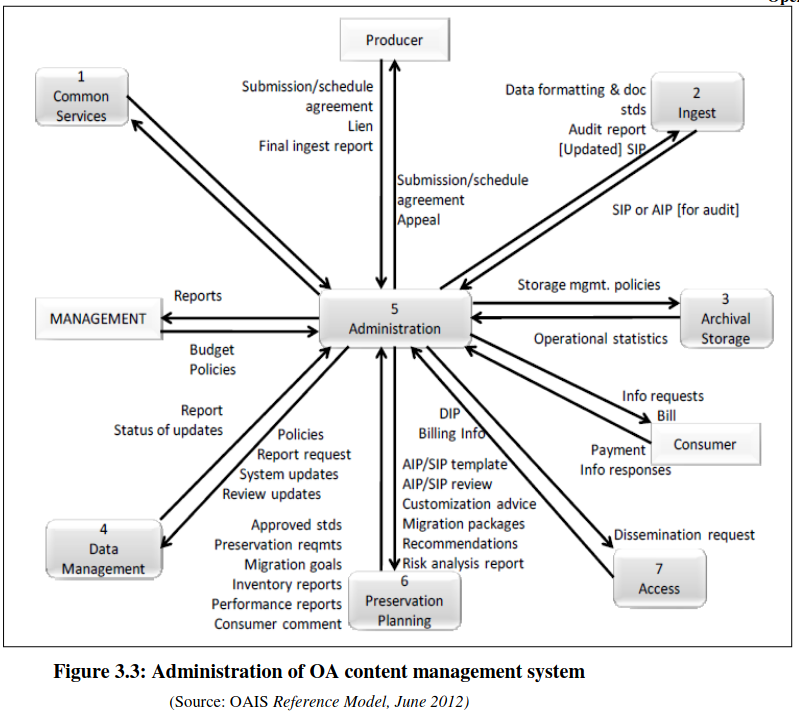2.2 OA Content Management: An Overview
By now, you are able to understand from previous unit of this module and from introduction to this unit that content management in open access (OA) is different from generic content management. Here, focus is concentrated on collection development, resource optimization, rights management, preservation, embargo management and similar other issues. However, typical content management functionalities in OA include – i) Collection development (deposition may be mandatory or optional; time frame of submission; forms and formats for OA objects); ii) Resource optimization (organization and management of deposited OA objects; categories & sub-categories; browsing services); iii) Contents coverage (types of OA resources to be included, languages of materials); iv) Copyright and Licensing policies (rights management; design/selection of licensing patterns); v) Data access (managing access to items; access pattern designing; re-use of items); vi) Embargo management (length of time bar in accessing OA objects); vii) Metadata management (metadata encoding, domain-specific schema selection and implementation; access to metadata; re-use of metadata;) viii) Privilege control (eligible depositors; collection level manager selection; authentication;); ix) Multilingual content management (incorporation of mechanisms to support storing, processing and retrieval of multilingual OA documents); x) Preservation of OA objects (retention period; file formats selection for preservation; functional preservation; backup and restoration); xi) Quality management (eligible reviewer; mechanisms of quality control); xii) Ingest (designing submission procedures, selection of eligible contributors; deposition rules; moderation, workflow for submission); xiii) System administration (policy implementation, maintenance, etc.); xiv) User interface (dissemination of OA contents through intuitive interface); xv) Version control (multiple versions control; up-gradation; errata and corrigenda lists); and xvi) Withdrawal of OA contents (purging, access to purged OA resources, reasons for withdrawal or removal etc.). An OA content manager needs to take decision in each of the above-mentioned issues related with OA content dissemination. So efficient OA content management needs support from global guidelines and best practices.
2.2.1 Designing a Framework for OA Content Management
This section focuses on designing a framework for OA content management on the basis of following guidelines:
- Data Information Specialists Committee -UK guide
- Open Access Information Resources: How We Evaluate Sites for inclusion
- On line OpenDOAR Policy Tool
- OAIS Reference Model
- TRAC checklist
- Open Access Scholarly Publishers Association, Code of Conduct
- Mullen, L. B. (2010). Open access and its practical impact on the work of academic librarians: collection development, public services, and the library and information science literature. Oxford: Chandos Pub;
- Mullen, L. B. (2011). Open access and collection development in academic libraries; digitization to discovery. IFLA Satellite Conference: Acquisition and Collection Development Section. University of the Virgin Islands;
- DOAJ Selection Criteria
The OAIS (Open Archival Information System) reference model25 proposed six functional groups for digital content management. This model is quite relevant for OA content management and naturally followed by many established OA service providers like OpenAIRE, DRIVER etc. These six functional entities are interrelated to each other (Figure 3.2) and spans from contributor to customer.

- Ingest function: This group acts as a central node for two processes namely SIP (Submission Information Package) & Archival Information Package (AIP) and two functions namely Data Management and Archival Storage. The workflow of the group includes receiving SIPs, checking quality of SIPs, preparing Archival Information Package (AIP) on the basis of formatting and documentation standards, generating Descriptive Information from the AIPs, populating the Archive database, and coordinating connection between Archival Storage and Data Management.
- Archival Storage function: The major workflow of this functional group is receiving AIPs from Ingest and appending them to permanent storage. This functional entity also manages storage hierarchy, maintains storage media, supports routine backup activities, allows restoration and disaster recovery capabilities, and provides AIPs to Access functional group.
- Data Management function: This group includes tasks to manage Archive database functions including database updates. It also handles queries, provides query responses, and produces reports from these query responses.
- Administration function:The broadest functional group of content management that starts from negotiating submission agreements with producers to content retrieval and interacts with all other functional groups continuously. It is also responsible for maintaining archive standards and configuration management of system hardware and software including migrate/update the contents of the Archive.
- Preservation planning function: Preservation of OA objects is one of the most important issues in content management. This functional group deals with policy issues related with contents formats, content migration, archival standards, technology environment etc and also performs risk analysis in content migration, templates designing for SIPs and AIPs, and implementation of Administration migration goals.
- Access function: It deals with user interface to OA contents. This group includes functions related to receiving users' requests, controlling access to protected resources, executing user’s queries, generating and delivering the responses to users and managing common services to customers.
The Administration functional entity acts as central node for other five functional groups and common services related users. The major information flow inside a content management system is illustrated by OAIS in Figure 3.3.

